World Oil Day: prospects for the future of the market
World Oil Day reminds us of the importance of this natural resource to the world. Read the content and check out the outlook for the future of this market.
World Oil Day is celebrated on September 29 and highlights the importance of this natural resource for global economic activity. Oil is one of the planet’s main sources of energy and generates the most consumed fuels in the world. It is the basis for the production of gasoline, diesel oil, kerosene and more. These products are heavily used due to their high efficiency in cars, trucks, buses and aircraft.
In this article, we’ll look at the current oil production scenario, the outlook for the future of the sector, the challenges of the energy transition and more. Read on!
The oil economy in the world
World oil production plays a central role in global energy supply. In 2022, Crude Oil was the best-selling product on the planet in monetary terms, reaching the $1.45 trillion mark. In the same year, this sector accounted for 6.13% of world trade.
In addition, global crude oil production grew by 1% in 2023. This was due to the increase in production in non-OPEC (Organization of Petroleum Exporting Countries) countries, such as the United States (+8.5% in 2023), Brazil (+12%) and Guyana. This growth has been constant since the 90s:
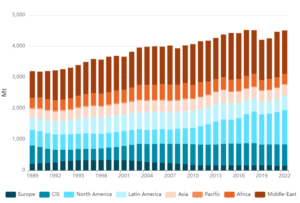
Source: Enerdata
Countries like the United States, Saudi Arabia, and Russia are the largest global producers, accounting for almost half of the world’s production. According to International Energy Statistics, the US produces more crude oil than any nation at any time.

Source: IBP
Including condensate oil, the United States reached an average of 12.9 million barrels produced per day in 2023. The previous record was 12.3 million, set in 2019 by the same country. Despite such high figures, the nation still imports oil as it is the largest consumer of this product in the world.
Last year, the United States consumed almost 19 million barrels of oil a day. The nation ranks third as the world’s largest importer. In 2023, China came first with more than 13.7 million barrels imported per day. Europe followed closely behind as the second largest importer, with 12.8 million barrels per day.
In terms of exports, Saudi Arabia led the way with US$ 310.6 billion exported in 2023. This figure corresponded to 16.3% of global exports that year. Russia, Canada, and the United States complete the world ranking of the largest exporters, respectively.
Read also:
- Driving season: the impact on the North American fuel market
Oil Day: the outlook for the future of the market
The outlook for the future of oil is directly related to the evolution of global demand and energy transition initiatives. According to the International Energy Agency (IEA), oil demand should continue to grow in the short term, with a peak expected in 2029.
OPEC reports the same growth, with a world demand of 108.3 million barrels (mb/d) of oil per day by 2030. After that, the market remains stable at 109.8 mb/d in 2045. See the graph below:
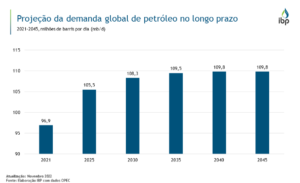
Source: IBP
In the energy transition, the role of oil is linked to the diversification of energies, since today’s reserves already proven by the producing countries should still last at least another 50 years. These figures can be found in OPEC’s Annual Statistical Bulletin 2024:
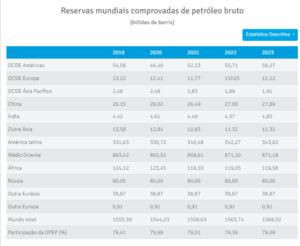
Source: OPEP
According to the organization, OPEC’s share of oil reserves will be 79.09% by 2023. The institution plays a key role in this market due to its large share of production. You can follow the breakdown between the participating countries in the graph below:
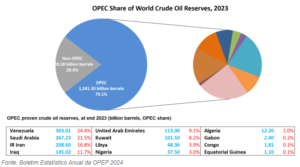
Source: OPEP
Created in 1960, the group has 12 countries to coordinate oil production and prices globally. Among the countries that are part of the organization are Saudi Arabia, Qatar, the United Arab Emirates and more.
As for oil prices, the U.S. Energy Information Administration (EIA) reports that values have mainly traded within a narrow range in 2024. The spot price of Brent crude oil, for example, averaged 82 dollars per barrel in August, marking the eighth consecutive month in which it has averaged between 80 and 90 dollars per barrel.
Below you’ll find data on prices in recent months and the short-term projections provided by the EIA:
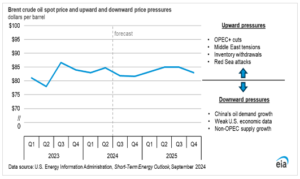
Read also:
- The influence of the US elections on the global economy
The importance of oil in the world economy
Crude oil is one of the world’s most important sources of energy because it has been the basis for economic and technological advances in recent decades. Today, the product continues to move the market both in physical trading and in derivatives, as well as being crucial in supplying vehicles, machinery and others.
More than just fuel, crude oil is also a raw material for plastics, cosmetics, fertilizers and paints. Its relevance is highly connected to the economy of importing and exporting countries, generating jobs and quality of life.
In Colombia, for example, the product is essential for the country, as it accounts for 31.3% of its exports. In the United States, the oil and gas industry was responsible for 12.3 million jobs in 2020.
Read also:
- 6 tips on how to follow the commodities market
Market intelligence dedicated to energy
World Oil Day reminds us of its enormous relevance to the global economy, both now and in the future. The natural resource will continue to play a crucial role in the world’s energy matrix.
Hedgepoint, with its market intelligence and trained experts, understands the role it plays in helping organizations navigate the challenges and opportunities of this dynamic sector.
Access our exclusive energy updates and keep abreast of global dynamics and trends.






